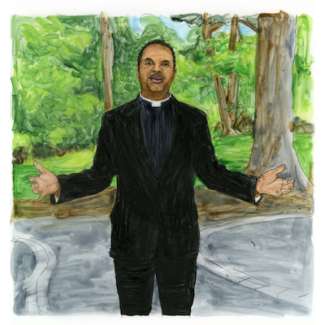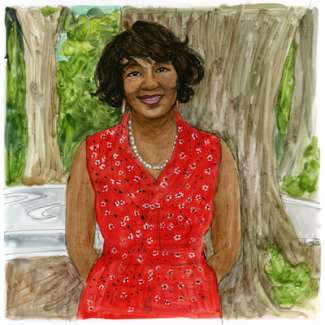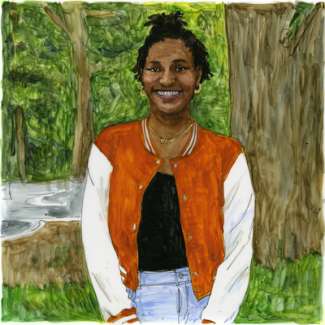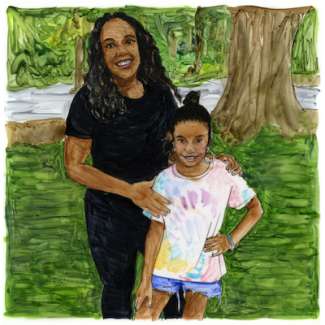Jump To:
Reverend Robert Jemonde Taylor
The Reverend Robert Jemonde Taylor is the eleventh rector of St. Ambrose Episcopal Church. His commitment to environmental justice and racial equality, and his personal connection to the land, deeply inform his ministry of resurrection and transformation, and his civic involvement.
Coming here to St. Ambrose helped me make a greater connection between the land and humanity.
I grew up on farmland in Franklin County, NC, which is only an hour north of Raleigh. This is the land that my father's side of the family has lived on since at least 1790: 75 years as enslaved Africans, and then in 1865, at the end of slavery, my ancestor approached his former enslaver to purchase 15 acres of land. He and his descendants accumulated more and more land, growing the farm to its current state. In my family, the land is personified. The land is a living family member.
St. Ambrose Episcopal Church is in the floodplain. We have a great probability of flooding.
In 1956, the City of Raleigh designated this area as one of two planned communities for Black people to live during segregation. Black people could only live in certain designated areas during segregation. This 39 acre community beside Walnut Creek in the wetland is Rochester Heights. The problem is the City dumped raw sewage into Walnut Creek for 70 years, from 1887 to 1956. The same year the city stopped dumping sewage, it zoned the area as an intentional Black community. I often say, “The City dumped raw sewage, garbage, and then they dumped Black people.”
Zoning this as a place for Black people to live was an example of environmental racism, and the proximity to Walnut Creek wetlands makes it flood prone. There are several homes along Bailey Drive where houses were washed off the foundation from flooding. This flooding is still a challenge today.
One of the chief challenges we face related to flooding is the development upstream. Rochester Heights and St. Ambrose sit at the end of a 46 square mile watershed. All the building and development in Cary, where Walnut Creek begins, and the development in Raleigh that paves over wooded and grass areas means more rain water runoff flowing to Walnut Creek. Development hardscapes lead to flooding headaches.
In the late 80s, Interstate 40 bisected the Black community, separating Rochester Heights from Biltmore Hills. This led to increased respiratory and noise pollution for the residents. We worked with an NC State University sound engineer who measured the noise level in Rochester Heights, and it's higher than other communities in Raleigh. Not only has water been an issue, but air quality and noise pollution as well.
Our newest effort is called the Healing Garden which uses therapeutic horticulture to help address the mental and emotional health needs of the Black community. Participating in the plant life cycle, the digging, planting, weeding, pruning, and harvesting, helps people process any emotional challenges that they're experiencing, including loss and grief.
This is about the liberation of Black people and the liberation of the environment. That is our purpose here. Watch Rev. Taylor tell his story.
Karyn C. Thomas
Karyn C. Thomas, a member of St. Ambrose Episcopal Church, is a native resident of the historic South Park Community, growing up during her youth in Biltmore Hills. Now retired, she worked as the Production Services Manager in the Communications Department for the City of Raleigh, where she was responsible for the operation of the city's Public, Education, and Government Access Channels.
I grew up in this neighborhood and community. Most people who are familiar with this historical community know that it is in a wetland, and there is an issue with flooding.
Over the years, I have been involved with the Wetlands Park. Helping with cleanup, I didn't always do the heavy lifting, I supported in other ways like food set up and making sure that volunteers are signed in and that they had all the tools they needed.
In my former job in the Communications Department of the City of Raleigh, I was the Production Services Manager for the City's cable franchises operation for Public, Education, and Government Access Television. My department was engaged in every aspect of the City of Raleigh’s media and communication needs for the purpose of connecting its citizens to various city-related initiatives and projects such as the Wetlands Center.
One of the most important Parks, Recreation, and Cultural Resources initiatives was the work that Dr. and Mrs. Camp and the Partners for Environmental Justice (PEJ) did in association and collaboration with North Carolina State University to establish the Wetland Center, and all the work around the annual cleanups. In 2018, the City of Raleigh Parks, Recreation, and Cultural Resources Department named the Wetlands Center in honor of Dr. Norman Camp III and his wife Betty Camp.
Another important theme is St. Ambrose Church’s partnership in that collaboration. I think when we think about St. Ambrose’s relationship with the wetlands, and it is an ongoing relationship, environmental justice is very important to our community. St. Ambrose continues to be instrumental in educating citizens about environmental justice and the impact environmental racism has had on the Rochester Heights - Biltmore Hills community. Preserving not just the natural habitat of the wetlands, but also educating citizens about the impact of flooding, and how we can mitigate these issues, is critically important for the preservation of our communities. Watch Karyn tell her story.
Katrel Thomas
Katrel Thomas is studying to be a mental health counselor. She is passionate about the importance of mental health awareness for minority communities.
My friend goes to church at St. Ambrose and she invited me to come to the event for Minority Mental Health month. We did a mud painting and it was really fun. We use stamps and stencils, different designs.
It's amazing for mental health, you never realized how much inner work that you have to do. Sometimes when your hands start working, the emotions happen. It’s really good to just put your hands to work, and really allow the creative juices to flow from your emotions to your hands. And the next thing you know, you just start moving, and you've created something beautiful, and you feel better.
I am currently a billing specialist and in school for mental health counseling. I know for a fact, as a person, as a minority myself, one of the biggest mental health struggles we encounter is just finding help. A lot of times in our community, it's hard to ask for help. We're not taught that that's an okay thing to do. So it's amazing, for a church where a lot of minorities go to commune and get the help that they need, to shine a light on Minority Mental Health Month and let them know your mental health is as important as your relationship with God.
I really tried to practice meeting people where they are. You have to be sensitive to the experience that someone's life has had on them. They may not be open to traditional mental health routes, but open to something like making mud stamps or doing some type of art therapy or music therapy. Sometimes you just have to meet people where they are and figure out how you can reach their mental health in a way that they'll accept. Watch Katrel tell her story.
Josie Wright and her mother, Rosie
Josie Wright and her mother, Rosie, live in Clayton and are members of St. Ambrose Congregation. They are very in tune to how important the wetlands are, not only for their church community, but for everybody around us.
We live in Clayton and are members of St. Ambrose going on a couple of years. We were new to the area, looking for a church home. We visited and never left. The biggest thing we like is the community. Everyone’s so kind, so welcoming. They've taken us in and it’s been great.
Q: Josie, what do you like about coming to church here?
J: I get to spend time with my church friends.
We are very in tune to how important the wetlands are not only for ourselves and our church community, but for everybody around us.
Josie: I don't like it when people litter. It's not kind. It's not helping.



